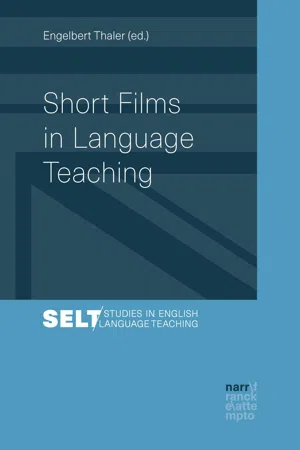
Short Films in Language Teaching
Engelbert Thaler, Engelbert Thaler
- 191 pages
- English
- ePUB (adapté aux mobiles)
- Disponible sur iOS et Android
Short Films in Language Teaching
Engelbert Thaler, Engelbert Thaler
À propos de ce livre
The second volume in the new academic series SELT (Studies in English Language Teaching) is also divided into three parts: A. Theory – B. Methodology – C. CIassroom. Part A highlights the topic from the perspectives of different academic disciplines, in this case from a TEFL as well as from a film-didactic and a cultural-literary viewpoint. In part B, methodological contributions on selected short films and suitable procedures are assembled. Part C is a collection of concrete sample lessons for teaching English with short films at various levels. These lesson plans have been designed at university, carried out and evaluated by 11 experienced teachers, and finally revised by the editor. Peer reviewing is guaranteed by an academic advisory council consisting of six well-known TEFL professors.The new series, above all, aims at bridging didactic research and classroom practice. Thus it is intended for foreign language lecturers, students, teacher trainers and teachers.
Foire aux questions
Informations
C. Lessons
New Silent Short Films
1 Genre
- As many short films are artistic, they have limited appeal in the commercial marketplace, so to make them easier to sell all around the globe, they often contain little or no dialogue, which makes comprehension easier.
- They offer intensely cinematic experiences, using images and movement, sequence and duration, sound and music.
- They are great for the language classroom as they can be used with any level – the teacher just needs to adapt the difficulty of the task to match the level of the students.
- Students have to compensate for the lack of dialogues by creating their own spoken or written output.
2 Procedure
Lesson A (lower grades)
Title | Gift (4:36 minutes) (https://www.youtube.com/watch?v=JMs7dkdO4YY) |
Synopsis | A family adopts a little girl for their daughter’s birthday. They play with her at first but after some time they lose their interest in the girl. Consequently, the girl seeks the family’s attention, and since she does not get any, messes up a room. This leads to a fight and the father takes the girl to abandon her in the wilderness. When he drives away, we see that the girl was actually a dog. The last shot shows the caption »Be responsible. Give, adopt wisely.« |
Competences | Listening-viewing, speaking, writing, lexical competence |
Topics | Gifts, pets, family, relationships, feelings |
Level | Lower intermediate |
Time | 45 min. |
Steps (Global-to-detail-approach) A. Lead-in 1. Realia: T shows S a wrapped gift and has S describe it. 2. T asks S about the best gift they have ever received. 3. T tells S they are going to watch a film called Gift and has S predict what the film may be about. B. First viewing The video is played straight through. C. Global comprehension 1. »What is the gift?« 2. »Did the ending surprise you? Why (not)?« 3. »What does the insert at the end of the film say? (Be responsible. Give, adopt wisely.) 4. »What does that mean?« D. Second viewing The video is shown again. | |
E. Detailed understanding 1. S put the film scenes into the right order, and write sentences to revise the plot (M 1). 2. S c... | |